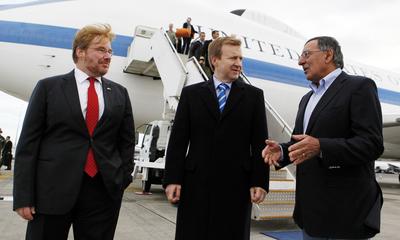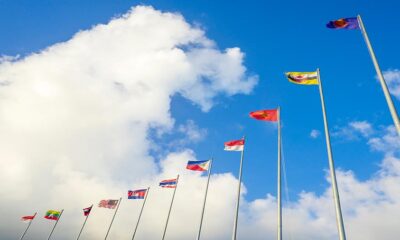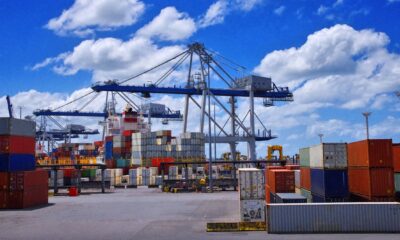Asean
Is New Zealand trapped in the Anglosphere?

Author: Gary Hawke, NZIER
The best headline among the usual profusion of journalistic reviews of New Zealand in 2012 is ‘Trivial Pursuits: The big news of the year is a margin-of-error-scale shift in the polls’.

Even in this context foreign affairs played little role in political commentary
but the longstanding importance of Asia to New Zealand remained a well-recognised and controversial issue.
New Zealand’s Defence White Paper 2010 gave primacy to ‘security partnerships’ with Australia, the United States, the United Kingdom and Canada as partnerships that are ‘grounded in common traditions, experiences, and values’. ‘Values’ was mentioned frequently throughout the White Paper, although it specified only ‘primacy of the rule of law, constraints on the unilateral exercise of force, and extending the same rights and responsibilities to all nations regardless of size or allegiance’ — values that are hardly unique to the Anglosphere. Preferring traditional allies can be supported by an idea of ‘social distance’, but its biggest element is really familiarity. Different economic interests and even different strategic alignments relative to Asia necessitate more incisive and innovative thinking.
Through 2012, diplomatic events, all minor and unquestioned in isolation, contributed to warming relations with ‘traditional’ allies. But key developments were elsewhere. Even in the South Pacific, usually seen as offering the clearest advantages of cooperation with the US and Australia, the biggest event in the year was the agreement with China and the Cook Islands for a tripartite approach to a specific aid project to improve water quality.
New Zealand’s stance on the Trans-Pacific Partnership (TPP) remained unchanged — it is a step toward a Free Trade Area of the Asia Pacific that would include China and all major economies in the region. It cannot be a means of ‘containing’ China.
Domestically, the controversy over the TPP was part of political theatrics. Critics concentrated on two issues: secrecy and extension beyond ‘trade’. Yet on the first issue, nobody showed that TPP procedures differed markedly from previous agreements, such as FTAs, WTO rounds, or, especially significant to New Zealand, the Closer Economic Relations negotiations. Open agreements secretly arrived at has been the rule. Of course, conventions change; not only are executive agreements now subject to parliamentary scrutiny — and if the efficacy of that can be questioned, it is hardly peculiar to the TPP — but there are also indications of a wider movement toward ‘participatory’ governance. The ‘stakeholder events’ in TPP negotiating rounds recognise this, going well beyond the business consultations that were an important part of the New Zealand–China agreement.
The second argument, that the TPP goes beyond ‘trade’ and infringes on sovereignty, is even more misconceived. The issue has always been economic interdependence, not ‘trade’, and the range of explicit agreements has been widening ever since tariff reduction was initiated. More importantly, all international agreements impose some constraint on domestic ‘policy space’. The protest is not against the TPP, but against a New Zealand government the protestors dislike but which is acting within its constitutional mandate (and presumably within its assessment of electoral opinion).
The new element in 2012 is the Regional Comprehensive Economic Partnership (RCEP), a proposed instrument for anchoring the ASEAN Economic Community in an appropriate regional and global setting, through an agreement with the existing ASEAN FTA partners: China, Japan, Korea Australia, India and New Zealand.
Beyond the obvious difference in membership of the RCEP — the US and other non-Asian members of the TPP being excluded and all of ASEAN and India being included — the approach of the RCEP will differ from the TPP. It will be much more focused on economic interdependence as a vehicle for inclusive economic growth, including explicit attention to development gaps. It will see international production networks as central rather than a chapter added to the familiar set of goods, services and investment. It will also probably rely more on agreed objectives and peer review than on ‘binding’ rules.
It is worth noting that the difference is not between a rules-based system and one built on capacity enhancement and cooperation. The difference between the RCEP and the TPP lies in the content of rules, not their existence, and about whether commitment is best developed through peer review or via some kind of supranational enforcement. All are differences of degree, but they amount to a need for New Zealand to adjust from the comfortable familiarity of the TPP format.
The New Zealand government has welcomed the RCEP and sees no incompatibility between it and the TPP — a view that is presumably shared in other countries which are parties to both the TPP and RCEP, Australia, Brunei, Malaysia, Singapore and Vietnam. Although incompatibility between the two agreements could emerge in specific provisions, this would first be addressed within ASEAN. In the meantime, New Zealand can continue to seek to avoid any divide between Asia and the Americas.
A wish to avoid any line through the Pacific Ocean is widely shared outside New Zealand as well as within it, but is under pressure. The United States is increasingly merely a significant partner of the Asian economies rather than their leader, while it remains a powerful and leading party in Asian security.
What differs in New Zealand is an unusual degree of complacency and a retreat to the familiar in non-economic affairs, resulting in an exclusion of the economic realities from public political debate. In 2012, New Zealand’s fear of change did not diminish, despite being the most significant constraint to the country’s future social and economic development.
Gary Hawke is an Associate Senior Fellow at the New Zealand Institute of Economic Research, and a member of the Academic Advisory Council of the Economic Research Institute for ASEAN and East Asia.
This is part of a special feature: 2012 in review and the year ahead.
Asean
Deadly Floods and Landslides Strike Indonesia and Thailand – Vietnam Plus

At least seven people were killed, two others were injured and some were likely to be missing after flash floods and landslides hit the Indonesian eastern province of Maluku on the morning of August 25, according to the locality’s disaster management and mitigation office.
Heavy rainfall, which began on August 24, has triggered the disasters in Ternate city. Many local residents are in urgent need of support, authorities said.
Soldiers, police, local search and rescue personnel, disaster management staff, and volunteers are all involved in the ongoing rescue efforts, which include evacuating those trapped by the landslides and recovering materials from homes swept away by the floods.
Meanwhile in Thailand, local authorities reported that the death toll from a landslide in the popular resort province of Phuket on August 23 has risen to 13, including a Russian couple.
Source : Floods, landslides kill many in Indonesia, Thailand – Vietnam Plus
Asean
Tug of War in Southeast Asia: Can ASEAN-China Dialogue Shift the Scales Toward Peace? – An Analysis

The ASEAN-China dialogue is vital for regional stability, addressing economic cooperation and security challenges, particularly in the South China Sea, amidst significant geopolitical complexities and ongoing territorial disputes.
ASEAN-China Dialogue: A Path Towards Cooperation
The ASEAN-China dialogue plays a pivotal role in Southeast Asia’s diplomacy, fostering economic collaboration while addressing security challenges. Despite advances, particularly in managing tensions in the South China Sea, significant barriers remain to achieving lasting peace and stability in the region. ASEAN’s capacity to maintain its unity and centrality is crucial amidst complex power dynamics involving China and other global players.
Navigating Tensions and Economic Relations
A pressing concern within this dialogue is the South China Sea territorial disputes, which involve multiple ASEAN states and China. The militarization of the area raises alarm among regional stakeholders, necessitating urgent negotiations for a Code of Conduct (COC) to manage conflicts. Additionally, the growing economic interdependence fostered by initiatives like the Regional Comprehensive Economic Partnership (RCEP) strengthens ASEAN-China ties, yet it also raises concerns about potential political leverage influencing member states’ autonomy.
The Challenge of Regional Stability
While the ASEAN-China dialogue offers a framework for promoting peace, its effectiveness is conditioned by broader geopolitical contexts, including China’s rivalry with the United States. The success of this dialogue rests on sustaining a commitment to multilateralism and peaceful dispute resolution. As ASEAN adapts to these complex dynamics, it must reinforce its unity and cooperative strategies, ensuring the region’s stability amid evolving challenges.
Source : Tug Of War In Southeast Asia: Will ASEAN-China Dialogue Tip The Balance Towards Peace? – Analysis
Asean
Cambodia Invites Business Leaders to Join the 21st China-ASEAN Expo in Nanning

Cambodia invites businesspeople to the 21st China-ASEAN Expo in Nanning, promoting trade and investment with incentives like hotel coupons and networking opportunities in various sectors.
Cambodia Invites Participation in CAEXPO 2024
Cambodia is actively encouraging business leaders, investors, and service providers to participate in the upcoming 21st China-ASEAN Expo (CAEXPO), set to take place from September 24-28 in Nanning, China. According to a Ministry of Commerce announcement, CAEXPO serves as a vital platform for trade and investment collaborations between ASEAN nations and China.
To facilitate Cambodian participation, the Ministry invites interested individuals to apply as Trade Visitors by August 31, 2024. Participants will benefit from hotel coupons, dining vouchers, and shuttle services to the expo venue. Furthermore, attendees can engage in business matchmaking in sectors such as food processing, digital technology, and renewable energy products.
Kin Phea, from the Royal Academy of Cambodia, emphasized the advancements in China-ASEAN relations, particularly concerning economic cooperation, tourism, and cultural exchanges. He noted that both sides have become each other’s largest trading partners, enhancing collaboration through the Belt and Road initiative, focusing on infrastructure and sustainable development.
Source : Cambodia encourages businesspeople to partake in 21st China-ASEAN Expo in Nanning












